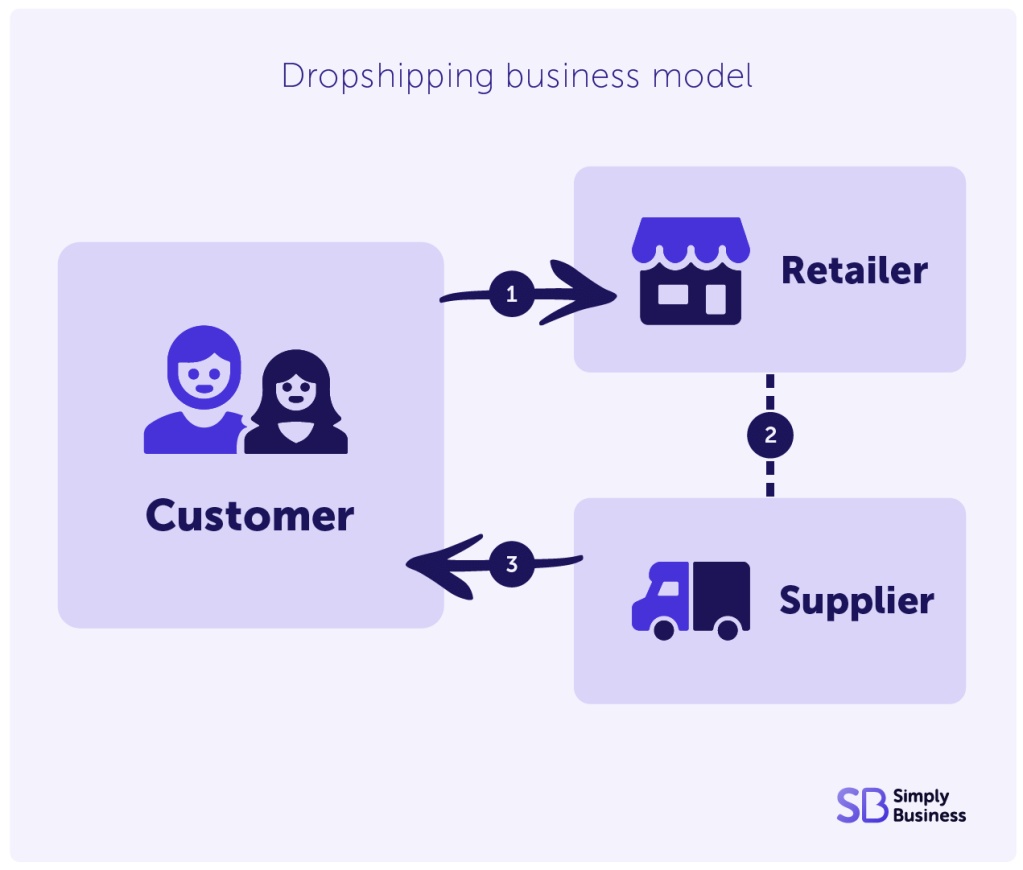Dropshipping has become a popular business trend over the last few years, with people setting up online shops as a side hustle or a full-time job.
But is dropshipping an effective way of starting a business with limited investment? Read our guide for an overview of how dropshipping works, how to launch your own shop, plus the downsides and risks involved.
- How does dropshipping work?
- How to start dropshipping in 4 steps
- How to make money dropshipping
- The pros and cons of dropshipping
- What insurance do dropshipping businesses need?
How does dropshipping work?
Dropshipping is a type of business model that allows online retailers to sell products without owning them, storing them, or shipping them.
Dropshippers can use a platform like Shopify or Amazon to sell products from a supplier. When a customer places an order through your shop, your supplier prepares and sends out the order on your behalf.
As the online retailer, you set the retail price paid by the customer and pay the supplier the wholesale price of the product, allowing you to keep the rest as profit.
To run a successful dropshipping business you’ll need to:
- choose popular products with a good profit margin
- work with a quality and reliable supplier
- market your shop effectively to maximise orders

How to start a dropshipping business in 4 steps
The idea of selling products without having to manage stock may appeal, so how do you get into dropshipping?
You can launch a dropshipping business fairly quickly and without having to invest too much of your own money. However, it’ll be time-consuming and it’s unlikely you’ll see instant results.
Below is an overview of the four main steps you need to take to get started.
1. Decide on your product
This is one of the first and most important decisions you’ll make. Ultimately, you’ll need to choose the right products to sell if you want to be a successful dropshipper.
You may want to pick a niche for your product, for example something to do with cycling, coffee, or chess.
A lot of dropshippers choose products related to animals, from toys for pets to clothing with animals on.
Launching a clothing brand is one of the most popular types of dropshipping. Sites like Everpress allow you to create your own t-shirt dropshipping business.
Here are 10 of the most popular products sold by dropshippers, according to Shopify:
- electric kitchen scales
- insulated mugs
- yoga socks
- LED face masks
- organic baby clothing
- pet supplements
- blackout curtains
- notepads
- air purifiers
- ring lights
Once you’ve got some ideas about what to sell, you’ll need to validate them. It’s important to make sure that they’re popular with consumers and have a big enough profit margin for you to make money.
Some steps to help validate your product ideas include:
- browsing Shopify’s trending products
- using Google Trends
- checking dropshipping supplier order volumes
Related guides
- How to do a competitor analysis for your small business
- What is SWOT analysis and how can it help your business strategy?
2. Pick a dropshipping platform
Dropshippers use an ecommerce platform to build their store and manage orders.
If you have the knowledge, you could build an ecommerce website yourself. However, most dropshipping entrepreneurs use an established platform.
When you receive an order, your ecommerce platform sends the details to your supplier which then fulfils the order for your customer.
The platform you use will need to integrate with your supplier, so it’s important that you research both options around the same time.
One of the most popular ecommerce platforms for dropshipping is Shopify. This is because you can use it to launch your own shop without needing web development or graphic design skills.
It also allows you to take an unlimited number of orders and stock an unlimited number of products.
Some other well-known ecommerce platforms used by dropshippers include:
- Volusion
- Ecwid
- BigCommerce
- Six
- Squarespace
You can also set up a dropshipping shop on well-known consumer sites such as:
If you go down this route, be careful to make sure you’re following their guidelines. Read our ultimate guide to setting up an online shop for more information.

insta_photos/stock.adobe.com
3. Choose your supplier
Alongside choosing your selling platform, you’ll also need to choose a supplier. Most dropshippers use an online marketplace that gives them access to a huge range of products and suppliers.
Remember, it’s important to make sure the supplier marketplace you choose integrates with your ecommerce platform.
Some of the most popular marketplaces for dropshippers include:
- AliExpress
- DSers
- Avasam
- SaleHoo
Here’s an overview of their starting costs, benefits, and features at a glance:
Supplier | Cost range | Benefits | Features |
AliExpress | 5% to 8% commission | Buyer protection if items arrive late or not as described | Compare which products to sell using analysis tool |
DSers | Free up to $499 a month | Process 100+ orders at once | Automated pricing, shipping, and supplier messages |
Avasam | Free up to $246 a month | Automate shipping and order processing | Integrates with major ecommerce platforms |
Salehoo | $27 p/m basic – $97 p/m premium | Access to trending products from AliExpress | Access to over 1,000 product suppliers |
Key questions to ask when choosing a dropshipping supplier
Here are some of the things you’ll need to consider when choosing a supplier:
1. Where are the products shipped from?
If your supplier’s products are shipped from China, you’ll need to factor in longer delivery times and higher shipping costs. For example, ePacket shipping is a cheaper and faster way to get products from China to the UK.
2. How does the marketplace’s technology work?
A marketplace that integrates with your shopping platform is essential. But you’ll also need to think about things like automation and inventory management. The bigger your shop gets, the more important the platform’s technology will become.
3. Do the products and suppliers have a good reputation?
As well as working out whether the supplier marketplace has the right products for your shop and target audience, you’ll need to do some research into its quality. Make sure you choose suppliers with good reviews for both the quality of their products and shipping.
4. Build your brand
Once you’ve set up your store, the next step is promoting it to customers.
You could have a slick store, brilliant products, and an interesting brand, but if no one can find your online shop, you won’t get any orders.
Building your brand will take a lot of time and effort. You’ll need to consider how you’ll make your store stand out in a crowded market. This could be visually, how you speak to customers, or the type of content you post.
It’s also worth checking on your competitors when creating your marketing strategy to get an idea of what works with your target market and what doesn’t.
Lots of successful brands build loyalty through reward schemes or discount codes. Promoting these online can create a buzz and encourage repeat orders.
Some of the most effective ways to build a dropshipping brand from scratch include:
social media advertising – alongside organic posting (sharing content for free on your feed), putting advertising budget into Facebook, Instagram, or TikTok can help you to reach a wide and engaged audience. Think carefully about what you’re going to promote and frequently analyse performance
SEO and content marketing – getting your shop to rank for key terms and phrases on Google can be highly effective. Make sure your content is helpful and written for consumers, rather than for the search engine
email marketing – if you can build a database of subscribers, sending them regular email communications can be a great way of generating business. Try not to oversell your products and consider personalisation to boost results
Read our complete guide to marketing for in-depth tips on how to build your brand.
How to make money dropshipping
Dropshipping is sometimes described as a passive income stream. However, it takes a lot of work to build a shop that delivers consistent sales and income.
Starting your own dropshipping business could cost up to £1,000 (although it can be done for less). Most shop owners look for a profit margin of around 20 per cent.
The amount a dropshipper can earn varies significantly, depending on how long their shop has been running and the type of products they sell.
Shopify estimates that new dropshipping businesses can generate between £850 and £1,750 a month within the first 12 months. This is based on a workload of 10 to 15 hours a week spent building your business.
That said, Shopfiy also says that only 10 to 20 per cent of dropshipping businesses succeed in the long term.
Revealed – the pros and cons of dropshipping
Starting a dropshipping business can be lucrative but as we’ve covered above, there’s a lot to think about before you can start making money.
3 advantages of dropshipping
- you don’t have to store stock or manage shipping of your products
- dropshipping has an unlimited income potential and can be a full-time job or side hustle
- it has low startup costs and the cost to maintain the business once it’s up and running can also be relatively low
3 disadvantages of dropshipping
- it’s a highly competitive market so it can be difficult to build an audience and get your shop noticed
- growing a dropshipping business takes a lot of time and effort
- dropshippers have limited control over the quality of their products, supply chains, and logistics
What kind of insurance do dropshipping businesses need?
It’s important that dropshippers protect their business with online retailer insurance. This type of cover usually includes:
- product liability insurance – in case your product causes injury or damage
- public liability insurance – in case a claim is made against you by a third-party for injuries or property damage
- employers’ liability insurance – in case an employee gets sick or injured while working for you
- legal expenses insurance – in case your business has legal problems, such as an employee dispute or tax investigation
As a dropshipper, one of your main concerns will be protecting items from being lost, stolen, or damaged during shipping.
Most dropshipping platforms cover this risk with a buyer protection guarantee that allows consumers to get a refund. However, make sure you research this thoroughly before choosing a dropshipping platform and launching your business.
If you start a dropshipping business, you’ll also need to pay tax once you make a certain amount of money. Read our guides to Self Assessment and side hustle tax for more information.
What are your tips for starting a dropshipping business? Let us know in the comments below.
Useful guides for small business owners
- How to make money from affiliate marketing
- What types of small business grants are available in the UK?
- Is work life balance possible when you have a side hustle?
- Is business insurance a legal requirement?
Ready to set up your cover?
As one of the UK’s biggest business insurance providers, we specialise in public liability insurance and protect more trades than anybody else. Why not take a look now and build a quick, tailored quote?
Monkey Business/stock.adobe.com
